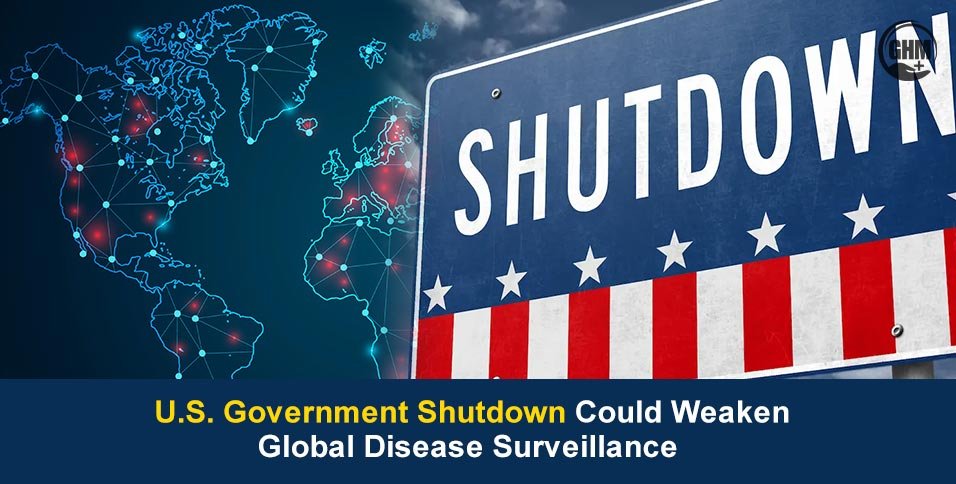The ongoing U.S. Government shutdown has forced federal health agencies, including the Centers for Disease Control and Prevention (CDC), to suspend major disease surveillance systems. These systems track everything from respiratory viruses to foodborne pathogens.
Health experts warn that this shutdown is not just a domestic crisis. When the U.S. pauses its disease-tracking networks, the ripple effects reach far beyond its borders.
The shutdown, now stretching into its third week, has left thousands of CDC and NIH employees furloughed. Programs that monitor influenza, COVID-19 variants, and emerging disease outbreaks have been temporarily scaled back or frozen.
Why the U.S. Surveillance Network Matters to the World
For decades, the United States has been a major part of global health monitoring. Through data-sharing partnerships and field labs, the CDC and allied U.S. agencies have supported over 60 countries in building disease-tracking systems.
Here’s how these programs typically support global health:
- Early Outbreak Detection: U.S. labs analyse international samples of influenza and other viruses, helping predict global trends.
- Data Sharing: American databases often serve as the foundation for global pathogen-tracking platforms.
- Technical Support: The CDC trains health officials abroad on genomic sequencing and outbreak analytics.
- Emergency Response: U.S.-funded rapid-response teams assist in outbreak containment worldwide.
The U.S. Government shutdown results in halting the funding or data flow. Therefore, this global chain weakens, delaying the identification of potential pandemics.
A Virus Season Without Data
The shutdown arrives just as the world enters its high-risk season, when influenza, Respiratory viruses, and COVID-19 cases typically surge. The CDC’s FluView dashboard, a primary source of weekly U.S. flu trends, is currently operating at limited capacity.
Public health agencies in Europe and Asia rely on U.S. healthcare data to calibrate vaccine strain selection and forecast outbreaks.
“If those numbers go dark, it creates blind spots for every health system connected to ours,” explained Dr Jennifer Nuzzo, Director of the Pandemic Centre at Brown University.
- Hospitals lose forecasting data for surge capacity planning.
- Researchers lose sequence information used to track viral evolution.
- Global health authorities, such as the WHO, lose timely outbreak alerts from U.S. networks.
What Happens When Surveillance Fails
Shutdown History:
- During the 2018 U.S. government shutdown, surveillance delays led to gaps in tracking the H3N2 influenza strain, later linked to a surge in global cases.
- Similarly, during COVID-19, lapses in genomic surveillance created time lags in detecting emerging variants.
In the current federal shutdown, the risks extend beyond viruses. Systems that monitor foodborne outbreaks, mosquito-borne diseases, and antimicrobial resistance are also scaled back.
This will have global consequences, where other countries may now detect outbreaks later, losing precious days for response and containment.
Delayed Action Due to Data Silence
Public health depends on data flow. Even short-term interruptions can cause long-term consequences.
When U.S. labs stop processing samples or reporting updates:
- Real-time modelling halts affecting global forecasts.
- International collaborations pause, especially joint research on emerging pathogens.
- Vaccine development lags due to missing genomic updates.
The U.S. Government shutdown has thus transformed from a budget standoff into a potential health security gap. This could impact outbreak preparedness worldwide.
Damage To Trust and Capacity
Beyond data loss, frequent shutdowns damage international confidence in U.S. leadership. Many global partners rely on U.S. consistency in funding and coordination. Repeated disruptions make it harder to sustain joint initiatives.
The U.S. invests billions annually in global health security. Each shutdown jeopardises years of infrastructure-building and undermines credibility in coordinated outbreak response.
Road Ahead
Experts predict that restarting surveillance systems after a shutdown is rarely instantaneous. Recalibrating labs, re-hiring furloughed analysts, and re-establishing international data sharing can take weeks. By then, critical seasonal data may be lost forever.
Some countries are already seeking to diversify data sources, building independent surveillance systems. While this decentralisation could strengthen resilience, it also signals a shift away from traditional U.S. leadership in global health.
Conclusion
The U.S. Government shutdown is often framed as a political or fiscal issue, but its real impact is biological, invisible yet immense.
Every paused lab test, delayed report, or suspended program weakens the world’s shared defence against disease.
When surveillance goes silent in one of the most connected countries on Earth, the entire world loses sight of what’s coming next.



















